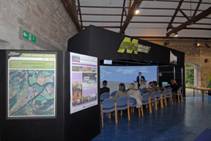| Case Study Number: | 1 | Case Study Title: | Mechanisms for engaging hard to reach audiences | ||||
| Contact details: | David Miller, Macaulay Land Use Research Institute | ||||||
| Principal target audience: | Public | Secondary target audience: | Policy makers | ||||
| Principal Work Package: | 3.1 | Secondary Work Package: | 3.8 | ||||
| Intended outcome(s): | Target audience inclusion in process of preparing the National Park Development Plan. Raised public awareness of opportunities to engage in planning, and of land use changes in a National Park. | ||||||
| Intended output(s): | Data on issues for inclusion in National Park Development Plan. The outputs were to inform the creation of an issues list for the National Park's Development Plan. | ||||||
| Relevance to a policy/stakeholder topic | Fairer Scotland, National Outcome - "Young people who are successful learners, confident individuals, effective contributors and responsible citizens"; Learning For Our Future: Scotland's First Action Plan for the UN Decade of Education for Sustainable Development; National Park Development Plan - Community Planning (Scotland) Act; Planning Advice Note 81: Community Engagement | ||||||
| Relevance to a Cross-Cutting Theme | Environmental, social and economic sustainability of rural Scotland | ||||||
Description |
|||||||
| Dates | June 07 to Nov 07 | Media | Virtual reality theatre, posters, Powerpoint slides | ||||
| Audience geography | Local to study area (i.e. rural communities within LLTNP), and urban conurbations (outwith LLTNP) | Legacy | Directly involving children in planning; increased public (school) awareness of planning in the National Park | ||||
| Shelf-life | 5 years (duration of Plan) 7 years (length of schooling) | Resources | 3D computer models of National Park, visualisation tools, aerial imagery of schools/ villages | ||||
The Loch Lomond and The Trossachs National Park Authority is preparing a new five-year development plan which will inform decisions in relation to land use and development. It attracted 900 people to a series of community planning for real events throughout the Park to gauge local opinions on issues of land use change. Complementing this series, the Macaulay Land Use Research Institute developed protocols and materials designed to engage hard to reach audiences of young people, by contributing to the school geography curriculum. These events featured the Virtual Landscape Theatre, in which pupils could work with computerised 3D models of the landscapes around the Park. 147 children, aged 6 to 17, from primary and secondary schools, and community youth groups, from in and around the Park participated at two venues, Gartocharn and Killin. They were run as one-hour sessions comprising familiarisation with the Park and local surroundings using aerial photographs; an introduction to the purpose of the event; a tour of the Park in the Virtual Landscape Theatre to describe the geography, land use and boundary of the Park; and a detailed look at the area local to the two venues (Photo 1). An electronic voting system recorded the views of participants on options for current and future land uses in the Park (Photo 2). The results suggest that wind turbine development in and around the Park should be for local needs only; there should be limited expansion of housing supply, avoiding areas of flood risk, and with a building design consistent with the character of the villages in the Park; and, there are generally sufficient woodlands, too much commercial plantations, and a desire for small-scale local woodlands for recreation. In the south of the Park, there was some disagreement between those living in the Park, who reported a lack of clothes, sports and convenience food shops, and those from outside who argued a sufficient range of shops close by. In the north-east, the lack of the same types of shops was reported. Participation in identifying priority issues included group feedback on the desirability of subjects (e.g. skateboard facility) and their general location, with modifications made towards group preferences accordingly. Test of electronic votes showed 87% response by participants to all votes, and 81% voting consistently on test questions. 94% reported enjoying the event. Follow-up surveys are being undertaken of teachers and pupils on the longer-term impact. Dissemination events have feedback on the protocols, tools and application to stakeholders with a remit to facilitate planning (e.g. Planning Aid Scotland), commercial companies and public bodies through the good practice workshop series run by Scottish Natural Heritage, and the Scottish Government, via an exhibition at its Victoria Quay headquarters in Edinburgh. ) |
|||||||
| Supporting materials (photographs, map, graph) |
 Voting on desired changes in land use, at Gartocharn, Loch Lomond and The Trossachs National Park (Dumbarton Academy) (12/06/07). Voting on desired changes in land use, at Gartocharn, Loch Lomond and The Trossachs National Park (Dumbarton Academy) (12/06/07). |
Dissemination at 'Sharing Good Practice Workshop: The Participant - The Place of People in the Planning System.' Scottish Natural Heritage (23/11/07). |
|||||
Feedback/evaluation |
|||||||
| Method | Pupil and teacher surveys (paper and electronic) Follow-up teacher survey (following year) Follow-up pupil survey (following year) |
||||||
| Results | Teacher assessment:
Relevance to curriculum - Very High (15 of 17) Quality of materials - Very High (14 of 17) Suitability for audience - Very High (14 of 17) Pupil assessment: Learnt something new - 78% Learnt something of relevance for class - 68% Follow-up surveys being undertaken | ||||||
| Endorsement | National Park use of data Teachers seeking re-run/follow-up of event |
||||||
| Reference | Engagement events: Engaging Young People in Planning - Public Event June 07 Dissemination events: Sharing Good Practice workshop - November 07 Demonstration of VLT at Scottish Government, Victoria Quay - August 07 |
||||||
|
Updated: 23 Jan 2024, Content by: DM
|

